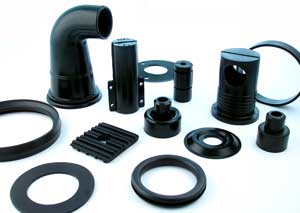Rubber Injection
 Rubber Injection Molding is an ideal process for forming high volume production rubber parts. This process is well suited for large quantities of small to medium size parts with complex inserts and close dimensional tolerances. With injection molding, an exact amount of rubber is forced or ‘injected’ into a closed cavity formed by two halves of a steel die that is pre-heated to the rubber’s curing or vulcanizing temperature. Because the injection action is both rapid and high pressure, the die is held in place by high pressure, thus forming the ‘part forming cavity’ and the die is ‘at temperature’, therefore, accelerating the curing process.
Rubber Injection Molding is an ideal process for forming high volume production rubber parts. This process is well suited for large quantities of small to medium size parts with complex inserts and close dimensional tolerances. With injection molding, an exact amount of rubber is forced or ‘injected’ into a closed cavity formed by two halves of a steel die that is pre-heated to the rubber’s curing or vulcanizing temperature. Because the injection action is both rapid and high pressure, the die is held in place by high pressure, thus forming the ‘part forming cavity’ and the die is ‘at temperature’, therefore, accelerating the curing process.
So, short cycle times, excellent dimensional capabilities imparted by the die and little process waste, all come together to make injection molding a low cost process for high volume parts. Because the cost of high precision dies is quite high, this technique is not suited for lower volume applications.
Rubber Injection Molding is used widely for many high volume products for consumer applications (rubber dog bones and door stops), industrial applications (grommets, o-rings) and transportation industry applications (protective boots for vulnerable automotive and truck steering and suspension systems).



